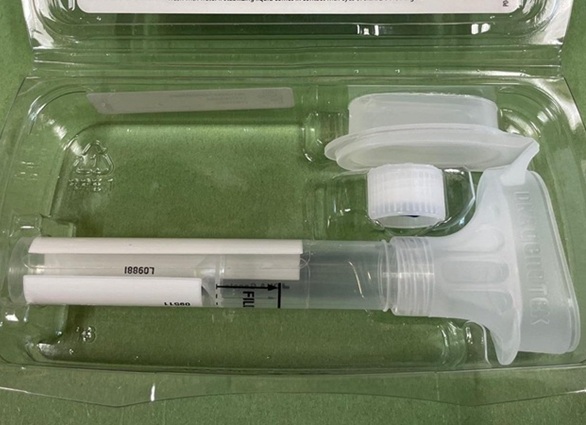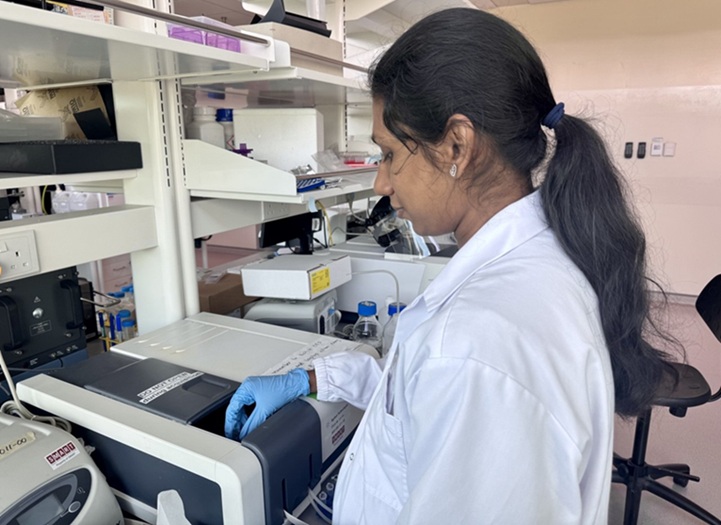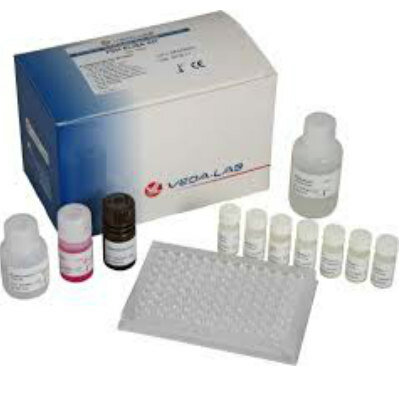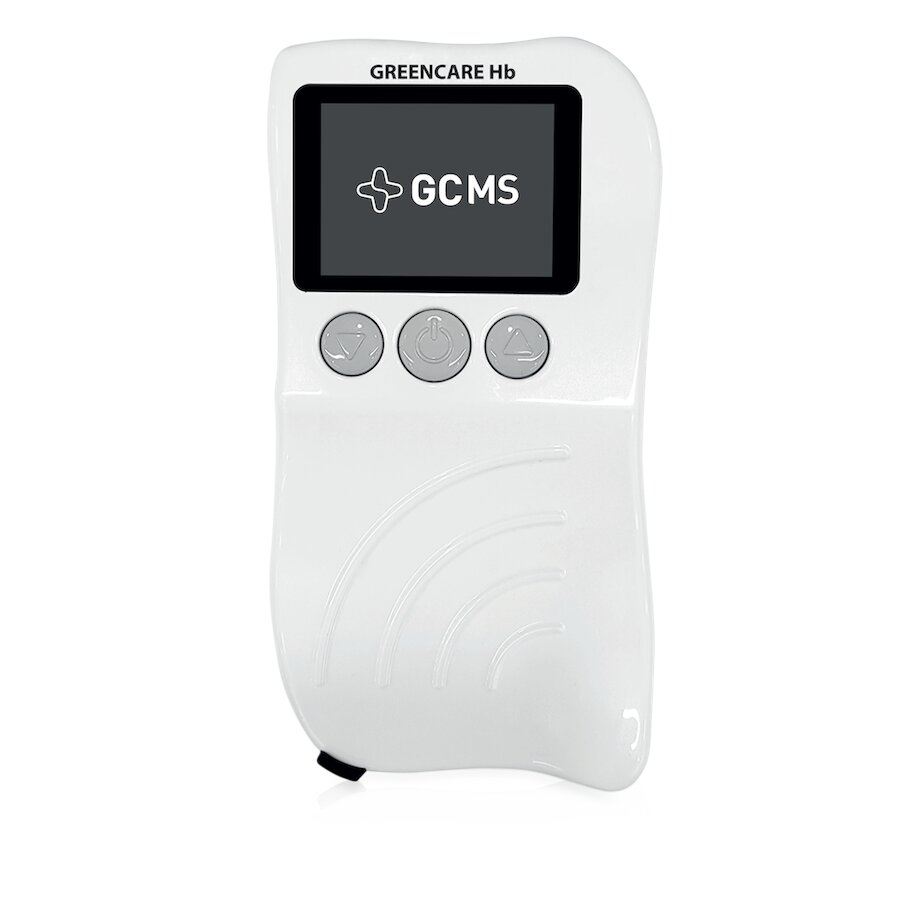Rapid Immunoassay Shows Potential for Lyme Disease Diagnosis
|
By LabMedica International staff writers Posted on 28 Oct 2019 |

Image: In this photomicrograph, the spiral-shaped bacteria that cause Lyme disease, Borrelia burgdorferi, have been illuminated using red and green fluorescent antibodies (Photo courtesy of the National Institute of Allergy and Infectious Diseases).
A three-antigen-based immunoassay for diagnosis of Lyme disease has the potential to be developed for point-of-care use.
Lyme disease, which is caused by the spiral-shaped bacterium Borrelia burgdorferi, may be difficult to diagnose, as it causes a wide range of symptoms, from fever and rash to neurologic and cardiac symptoms and joint pain.
The most widely used method for Lyme diagnosis is testing for antibodies in the blood by ELISA and Western blot. A two-tiered protocol is recommended by the [U.S.] Centers for Disease Control and Prevention (CDC): the sensitive ELISA test is performed first, and if it is positive or equivocal, then the more specific Western blot is run. However, the reliability of the CDC two-tiered protocol is controversial.
Studies have shown that the Western blot IgM has a specificity of 94–96% for individuals with clinical symptoms of early Lyme disease. The initial ELISA test has a sensitivity of about 70%, and in two-tiered testing, the overall sensitivity is only 64%, although this rises to 100% in the subset of people with disseminated symptoms, such as arthritis. Erroneous test results have been widely reported in both early and late stages of the disease, and can be caused by several factors, including antibody cross-reactions from other infections, including Epstein–Barr virus and cytomegalovirus, as well as herpes simplex virus.
As an alternative to the two-tiered protocol, investigators at NIH/National Institute of Allergy and Infectious Diseases (Bethesda, MD, USA) and collaborators at several institutions including Columbia University (New York, NY, USA) and the University of Tennessee Health Science Center (Memphis, USA) developed a sensitive immunoassay based on three Borrelia burgdorferi antigens.
The investigators used human serum rigorously characterized as acute and convalescent early Lyme disease, Lyme arthritis, and post treatment Lyme disease syndrome, as well as the necessary control samples to select the best of 12 Borrelia burgdorferi proteins to improve their microfluidic assay (mChip-Ld). The operation of mChip is similar to that of ELISA for determining serum antibody concentrations. The mChip contains 10 zones, which detect the passage of a small amount (about one microliter) of blood. The results can be obtained in a color-coded format in about 15 minutes.
The investigators selected three antigens (3Ag) to include in the mChip-Ld: VlsE and a proprietary synthetic 33-mer (repeat units) peptide (PepVF) to capture sensitivity in all disease stages, and OspC for early Lyme disease.
Results revealed that these biomarkers were more effective than those previously used at identifying signs of Lyme disease infection in early stage samples, possibly as these antigens were able to detect antibodies that peaked in the first two to six weeks following infection.
The investigators suggested that their results opened the door for the development of a single, rapid, multiplexed diagnostic test for point-of-care use that could be designed to identify Lyme disease stage.
The study was published in the October 9, 2019, online edition of the Journal of Clinical Microbiology.
Related Links:
NIH/National Institute of Allergy and Infectious Diseases
Columbia University
University of Tennessee Health Science Center
Lyme disease, which is caused by the spiral-shaped bacterium Borrelia burgdorferi, may be difficult to diagnose, as it causes a wide range of symptoms, from fever and rash to neurologic and cardiac symptoms and joint pain.
The most widely used method for Lyme diagnosis is testing for antibodies in the blood by ELISA and Western blot. A two-tiered protocol is recommended by the [U.S.] Centers for Disease Control and Prevention (CDC): the sensitive ELISA test is performed first, and if it is positive or equivocal, then the more specific Western blot is run. However, the reliability of the CDC two-tiered protocol is controversial.
Studies have shown that the Western blot IgM has a specificity of 94–96% for individuals with clinical symptoms of early Lyme disease. The initial ELISA test has a sensitivity of about 70%, and in two-tiered testing, the overall sensitivity is only 64%, although this rises to 100% in the subset of people with disseminated symptoms, such as arthritis. Erroneous test results have been widely reported in both early and late stages of the disease, and can be caused by several factors, including antibody cross-reactions from other infections, including Epstein–Barr virus and cytomegalovirus, as well as herpes simplex virus.
As an alternative to the two-tiered protocol, investigators at NIH/National Institute of Allergy and Infectious Diseases (Bethesda, MD, USA) and collaborators at several institutions including Columbia University (New York, NY, USA) and the University of Tennessee Health Science Center (Memphis, USA) developed a sensitive immunoassay based on three Borrelia burgdorferi antigens.
The investigators used human serum rigorously characterized as acute and convalescent early Lyme disease, Lyme arthritis, and post treatment Lyme disease syndrome, as well as the necessary control samples to select the best of 12 Borrelia burgdorferi proteins to improve their microfluidic assay (mChip-Ld). The operation of mChip is similar to that of ELISA for determining serum antibody concentrations. The mChip contains 10 zones, which detect the passage of a small amount (about one microliter) of blood. The results can be obtained in a color-coded format in about 15 minutes.
The investigators selected three antigens (3Ag) to include in the mChip-Ld: VlsE and a proprietary synthetic 33-mer (repeat units) peptide (PepVF) to capture sensitivity in all disease stages, and OspC for early Lyme disease.
Results revealed that these biomarkers were more effective than those previously used at identifying signs of Lyme disease infection in early stage samples, possibly as these antigens were able to detect antibodies that peaked in the first two to six weeks following infection.
The investigators suggested that their results opened the door for the development of a single, rapid, multiplexed diagnostic test for point-of-care use that could be designed to identify Lyme disease stage.
The study was published in the October 9, 2019, online edition of the Journal of Clinical Microbiology.
Related Links:
NIH/National Institute of Allergy and Infectious Diseases
Columbia University
University of Tennessee Health Science Center
Latest Microbiology News
- Handheld Device Delivers Low-Cost TB Results in Less Than One Hour
- New AI-Based Method Improves Diagnosis of Drug-Resistant Infections
- Breakthrough Diagnostic Technology Identifies Bacterial Infections with Almost 100% Accuracy within Three Hours
- Innovative ID/AST System to Help Diagnose Infectious Diseases and Combat AMR
- Gastrointestinal Panel Delivers Rapid Detection of Five Common Bacterial Pathogens for Outpatient Use
- Rapid PCR Testing in ICU Improves Antibiotic Stewardship
- Unique Genetic Signature Predicts Drug Resistance in Bacteria
- Unique Barcoding System Tracks Pneumonia-Causing Bacteria as They Infect Blood Stream
- Rapid Sepsis Diagnostic Test Demonstrates Improved Patient Care and Cost Savings in Hospital Application
- Rapid Diagnostic System to Detect Neonatal Sepsis Within Hours
- Novel Test to Diagnose Bacterial Pneumonia Directly from Whole Blood
- Interferon-γ Release Assay Effective in Patients with COPD Complicated with Pulmonary Tuberculosis
- New Point of Care Tests to Help Reduce Overuse of Antibiotics
- 30-Minute Sepsis Test Differentiates Bacterial Infections, Viral Infections, and Noninfectious Disease
- CRISPR-TB Blood Test to Enable Early Disease Diagnosis and Public Screening
- Syndromic Panel Provides Fast Answers for Outpatient Diagnosis of Gastrointestinal Conditions
Channels
Clinical Chemistry
view channel
‘Brilliantly Luminous’ Nanoscale Chemical Tool to Improve Disease Detection
Thousands of commercially available glowing molecules known as fluorophores are commonly used in medical imaging, disease detection, biomarker tagging, and chemical analysis. They are also integral in... Read more
Low-Cost Portable Screening Test to Transform Kidney Disease Detection
Millions of individuals suffer from kidney disease, which often remains undiagnosed until it has reached a critical stage. This silent epidemic not only diminishes the quality of life for those affected... Read more
New Method Uses Pulsed Infrared Light to Find Cancer's 'Fingerprints' In Blood Plasma
Cancer diagnoses have traditionally relied on invasive or time-consuming procedures like tissue biopsies. Now, new research published in ACS Central Science introduces a method that utilizes pulsed infrared... Read moreHematology
view channel
New Scoring System Predicts Risk of Developing Cancer from Common Blood Disorder
Clonal cytopenia of undetermined significance (CCUS) is a blood disorder commonly found in older adults, characterized by mutations in blood cells and a low blood count, but without any obvious cause or... Read more
Non-Invasive Prenatal Test for Fetal RhD Status Demonstrates 100% Accuracy
In the United States, approximately 15% of pregnant individuals are RhD-negative. However, in about 40% of these cases, the fetus is also RhD-negative, making the administration of RhoGAM unnecessary.... Read moreImmunology
view channel
Stem Cell Test Predicts Treatment Outcome for Patients with Platinum-Resistant Ovarian Cancer
Epithelial ovarian cancer frequently responds to chemotherapy initially, but eventually, the tumor develops resistance to the therapy, leading to regrowth. This resistance is partially due to the activation... Read more
Machine Learning-Enabled Blood Test Predicts Immunotherapy Response in Lymphoma Patients
Chimeric antigen receptor (CAR) T-cell therapy has emerged as one of the most promising recent developments in the treatment of blood cancers. However, over half of non-Hodgkin lymphoma (NHL) patients... Read moreMicrobiology
view channel
Handheld Device Delivers Low-Cost TB Results in Less Than One Hour
Tuberculosis (TB) remains the deadliest infectious disease globally, affecting an estimated 10 million people annually. In 2021, about 4.2 million TB cases went undiagnosed or unreported, mainly due to... Read more
New AI-Based Method Improves Diagnosis of Drug-Resistant Infections
Drug-resistant infections, particularly those caused by deadly bacteria like tuberculosis and staphylococcus, are rapidly emerging as a global health emergency. These infections are more difficult to treat,... Read more
Breakthrough Diagnostic Technology Identifies Bacterial Infections with Almost 100% Accuracy within Three Hours
Rapid and precise identification of pathogenic microbes in patient samples is essential for the effective treatment of acute infectious diseases, such as sepsis. The fluorescence in situ hybridization... Read morePathology
view channel
Spit Test More Accurate at Identifying Future Prostate Cancer Risk
Currently, blood tests that measure the level of a protein called prostate-specific antigen (PSA) are commonly used to identify men at higher risk for prostate cancer. This test is typically used based... Read moreDNA Nanotechnology Boosts Sensitivity of Test Strips
Since the Covid-19 pandemic, most people have become familiar with paper-based rapid test strips, also known as lateral flow immunoassays (LFIAs). These tests are used to quickly detect biomarkers that... Read more
Novel UV and Machine Learning-Aided Method Detects Microbial Contamination in Cell Cultures
Cell therapy holds great potential in treating diseases such as cancers, inflammatory conditions, and chronic degenerative disorders by manipulating or replacing cells to restore function or combat disease.... Read moreTechnology
view channel
Disposable Microchip Technology Could Selectively Detect HIV in Whole Blood Samples
As of the end of 2023, approximately 40 million people globally were living with HIV, and around 630,000 individuals died from AIDS-related illnesses that same year. Despite a substantial decline in deaths... Read more
Pain-On-A-Chip Microfluidic Device Determines Types of Chronic Pain from Blood Samples
Chronic pain is a widespread condition that remains difficult to manage, and existing clinical methods for its treatment rely largely on self-reporting, which can be subjective and especially problematic... Read more
Innovative, Label-Free Ratiometric Fluorosensor Enables More Sensitive Viral RNA Detection
Viruses present a major global health risk, as demonstrated by recent pandemics, making early detection and identification essential for preventing new outbreaks. While traditional detection methods are... Read moreIndustry
view channel
Cepheid and Oxford Nanopore Technologies Partner on Advancing Automated Sequencing-Based Solutions
Cepheid (Sunnyvale, CA, USA), a leading molecular diagnostics company, and Oxford Nanopore Technologies (Oxford, UK), the company behind a new generation of sequencing-based molecular analysis technologies,... Read more
Grifols and Tecan’s IBL Collaborate on Advanced Biomarker Panels
Grifols (Barcelona, Spain), one of the world’s leading producers of plasma-derived medicines and innovative diagnostic solutions, is expanding its offer in clinical diagnostics through a strategic partnership... Read more




















